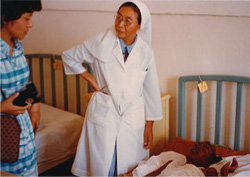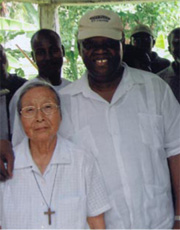Home > Highlighting JAPAN > Highlighting Japan OCTOBER 2011 > The Mother Theresa of Haiti
Highlighting JAPAN
COVER STORY: Japan’s Women on Top of the World
The Mother Theresa of Haiti
The major earthquake that struck Haiti in January 2010 caused serious damage and left countless people homeless. Many are still without a home today. Outbreaks of cholera and other infectious diseases have made a bad situation even worse. Akiko Sudo has been providing medical assistance in Haiti for over thirty years. Known as the Mother Theresa of Haiti by local people, she is still actively helping the Haitian community at the age of eighty-four. The Japan Journal’s Osamu Sawaji reports.

Akiko Sudo at the Sanatorium of Sigueneau in Léogâne in the 1980s
Having qualified as a doctor shortly after World War II, Sudo worked until 1972 treating tuberculosis patients at a hospital run by a Catholic religious order in the city of Nishinomiya in Hyogo Prefecture. Tuberculosis used to be regarded fearfully in Japan, as a deadly illness for which there was no cure. Thanks to the spread of antibiotics and advances in immunization, diagnosis and other countermeasures since the war however, the mortality rate has been drastically reduced.
“I wanted to introduce Japanese countermeasures to Haiti in order to eradicate tuberculosis,” recalls Sudo.
The religious order that Sudo belongs to was planning to set up a branch in Haiti at around the same time, so she asked the heads of the order to be sent over to Haiti. In October 1976, Sudo was dispatched by the heads of the order, and in December 1977 was appointed by Haiti’s Ministry of Health to work as a doctor at the Sanatorium of Sigueneau in a town called Léogâne, roughly 30 kilometers to the west of the Haitian capital Port-au-Prince.
The reality that faced Sudo however was extremely tough. Despite its name, the sanatorium had no medical facilities whatsoever. There was no electricity, no running water, and a shortage of beds for patients, many of whom had to sleep on the floor. Sudo was also confronted with serious social issues too, including a high rate of illiteracy and a lack of infrastructure.
Working with Haitian sisters, doctors and nurses, Sudo began to set up hospital facilities at the sanatorium, with assistance from countries such as Canada and Japan. They installed medical equipment and dug a well in order to provide clean water. Although the sanatorium was set up to provide treatment for tuberculosis, it still had a steady stream of out patients and was forced to treat external injuries in some cases. Sudo worked flat-out examining and treating patients, morning, noon and night. By the 1980s, the sanatorium had built a treatment center and a medical ward for critical patients, with the help of the Japanese government. Sudo continued to improve its medical facilities however, in her capacity as director of the sanatorium.
Sudo handed over the reins to a Haitian doctor in the mid-1980s, but continued to treat patients and provide advice regarding hospital management in a new role as international director. From the latter part of the 1980s onwards however, Haiti was plunged into political and economic turmoil as a result of a coup and economic sanctions imposed by the United Nations. Despite frequent outbreaks of rioting and looting around the town, and the fact that many foreign citizens had fled the country, Sudo refused to abandon her patients and remained in Haiti. Amidst all the chaos, one patient said to her, “Don’t worry, Sister, we’ll protect you,” words that have stayed with her ever since. “When I realized that they trusted and loved me so much that they were willing to risk their lives to protect me, I was so touched,” says Sudo. “At the end of the day, it’s love that keeps people alive.”

Before the Haiti Earthquake, Akiko Sudo met then-Agriculture Minister François Severi (right), who promised to provide national land for the agricultural school that Sudo planned to establish.
Hopes for Haiti
Despite retiring from the sanatorium in 2008, at the age of eighty-one, Sudo stayed on in Haiti and worked to establish an agricultural school to help local people achieve independence. With plans for the school going well, she came back to Japan for a visit. It was then, on January 12, 2010, that the Haiti earthquake struck.
“I was stunned,” says Sudo. “I had been in Haiti for over thirty years, and I couldn’t remember a single earthquake during that time.”
Sudo was keen to head straight back to Haiti after the quake, but was unable to establish contact. It wasn’t until late April, three months on from the earthquake, that she finally managed to get back to Léogâne.
Unfortunately, all eight of the buildings at the Sanatorium of Sigueneau had been either fully or partially destroyed by the earthquake, leaving roughly sixty patients to undergo treatment in tents, outside in the scorching heat.
Sudo immediately set about getting them the water they needed. She also entered into negotiations with the Japanese government, UN bodies and NGOs in an effort to get the hospital rebuilt. As a result, the sanatorium’s laundry block was built by members of the Japan Self-Defense Forces in July this year. Although the medical ward still hasn’t been rebuilt, the patients will move into a temporary hospital built by the Swiss Red Cross in the near future.
“When I see people in Haiti, particularly children, who are still positive despite living with such hardship and poverty, I feel like I am the one who has been saved,” says Sudo. “I have always tried to do my bit to help patients, but they are the ones who have inspired me to keep going. People cannot live alone. There is only hope when we come together to help one another.”
© 2009 Cabinet Office, Government of Japan






